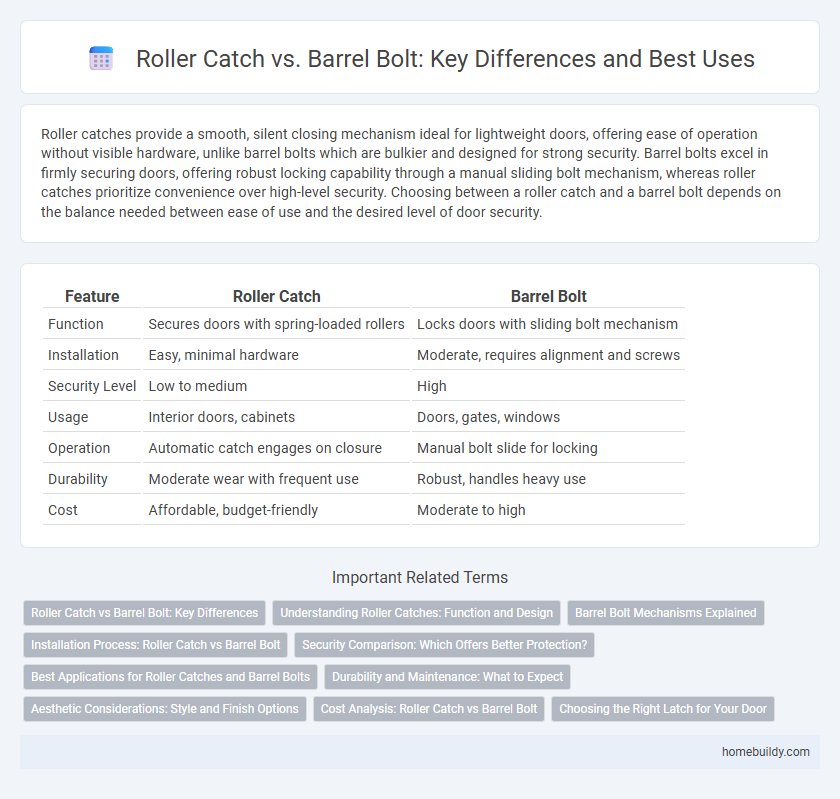Roller catches provide a smooth, silent closing mechanism ideal for lightweight doors, offering ease of operation without visible hardware, unlike barrel bolts which are bulkier and designed for strong security. Barrel bolts excel in firmly securing doors, offering robust locking capability through a manual sliding bolt mechanism, whereas roller catches prioritize convenience over high-level security. Choosing between a roller catch and a barrel bolt depends on the balance needed between ease of use and the desired level of door security.
Table of Comparison
| Feature | Roller Catch | Barrel Bolt |
|---|---|---|
| Function | Secures doors with spring-loaded rollers | Locks doors with sliding bolt mechanism |
| Installation | Easy, minimal hardware | Moderate, requires alignment and screws |
| Security Level | Low to medium | High |
| Usage | Interior doors, cabinets | Doors, gates, windows |
| Operation | Automatic catch engages on closure | Manual bolt slide for locking |
| Durability | Moderate wear with frequent use | Robust, handles heavy use |
| Cost | Affordable, budget-friendly | Moderate to high |
Roller Catch vs Barrel Bolt: Key Differences
Roller catches provide smooth, concealed latching by using a spring-loaded roller to hold doors lightly closed, ideal for interior applications requiring quick access. Barrel bolts offer a more secure, visible locking mechanism through a sliding bolt that secures doors or gates firmly in place. Key differences include roller catches prioritizing convenience and ease of use, while barrel bolts deliver enhanced security and stronger door fastening.
Understanding Roller Catches: Function and Design
Roller catches use spring-loaded rollers to secure doors by engaging with a strike plate, offering smooth operation and easy release, unlike barrel bolts which rely on manual sliding bolts for locking. Their design provides concealed latching mechanisms that minimize wear and reduce noise, making roller catches suitable for interior doors and cabinets. The functional advantage of roller catches lies in their ability to maintain door alignment and provide a consistent catch pressure without mechanical locking.
Barrel Bolt Mechanisms Explained
Barrel bolt mechanisms consist of a sliding metal rod that fits into a catch or socket, providing secure and straightforward locking for doors or gates. Compared to roller catches, barrel bolts offer a more robust physical barrier, enhancing security by preventing unauthorized entry. The simplicity and durability of barrel bolts make them ideal for applications requiring a reliable and visible locking method.
Installation Process: Roller Catch vs Barrel Bolt
The installation process of a roller catch involves fitting a spring-loaded roller mechanism into a strike plate and door edge, requiring precise alignment for smooth operation. In contrast, a barrel bolt installation is simpler, consisting of securing a metal bolt onto the door and corresponding frame with screws, demanding less precise positioning. Roller catches typically need more detailed adjustments during installation, while barrel bolts offer straightforward, quick mounting.
Security Comparison: Which Offers Better Protection?
Roller catches provide moderate security by securing doors with spring-loaded rollers, best suited for interior or light-use doors, whereas barrel bolts offer superior protection through a solid metal bolt that firmly locks the door in place, ideal for high-security needs. Barrel bolts resist forced entry more effectively due to their robust construction and direct engagement with the door frame, outperforming roller catches in security-critical applications. For enhanced safety, especially on exterior or vulnerable doors, barrel bolts present a more reliable locking mechanism compared to roller catches.
Best Applications for Roller Catches and Barrel Bolts
Roller catches excel in applications requiring smooth, push-to-close doors such as cabinet doors, closet doors, and interior screens, providing a quiet and consistent hold without the need for a latch mechanism. Barrel bolts are better suited for securing external doors, gates, or high-security areas where a strong, visible locking mechanism is necessary to enhance security and prevent forced entry. Choosing between roller catches and barrel bolts depends on the balance between ease of access and security level required for the specific door type and usage environment.
Durability and Maintenance: What to Expect
Roller catches offer better durability with fewer moving parts that resist wear over time, compared to barrel bolts which have more components prone to corrosion and mechanical failure. Maintenance for roller catches is minimal, often requiring only occasional lubrication, whereas barrel bolts demand regular inspection and tightening to prevent misalignment and ensure smooth operation. Choosing roller catches reduces long-term upkeep costs and enhances reliability in high-traffic doors.
Aesthetic Considerations: Style and Finish Options
Roller catches offer a sleek, low-profile design that integrates seamlessly with contemporary door styles, making them ideal for modern interiors seeking minimalistic hardware. In contrast, barrel bolts have a more utilitarian appearance, often protruding visibly and available in limited finishes, which may detract from refined aesthetic schemes. The extensive range of finishes for roller catches, including brushed nickel, antique brass, and matte black, allows greater customization to match door hardware and decor trends, enhancing overall visual harmony.
Cost Analysis: Roller Catch vs Barrel Bolt
Roller catches typically cost less than barrel bolts due to simpler materials and manufacturing processes, making them an economical choice for light to medium door applications. Barrel bolts offer greater security but come with higher installation and material costs, which can impact overall project budgets. Evaluating long-term durability and maintenance expenses also favors roller catches for lower upfront and upkeep costs.
Choosing the Right Latch for Your Door
A roller catch provides smooth, automatic engagement and easy one-handed operation, ideal for lightweight interior doors, while a barrel bolt offers secure, manual locking best suited for exterior or high-security applications. Roller catches reduce door slam noise and wear, promoting longevity in everyday use. Selecting between the two depends on the balance between convenience and security requirements for your specific door installation.
roller catch vs barrel bolt Infographic

 homebuildy.com
homebuildy.com